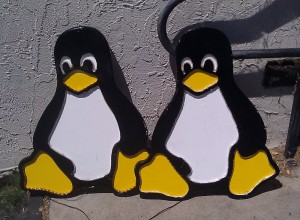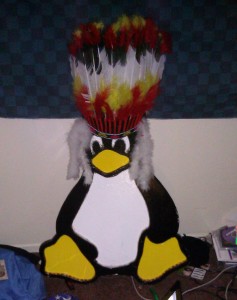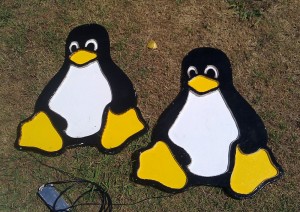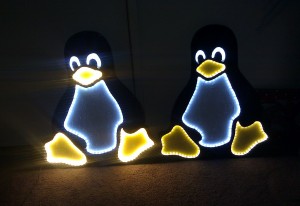

 The inspiration for this piece came from a friend who mentioned that she was going to the Digital Renaissance Faire and whose theme camp was the Polar Ambassadors. I suggested that they use Tux the Linux penguin for a mascot, as I pointed to the sticker on the front of my laptop. She told me that I should join their camp and make him the official camp mascot. With an offer like that, how could I refuse? I came up with the idea for these light-emitting penguins as a way to call out to fellow nerds; a “nerd magnet” to assist me in my perpetual quest of targeted social networking.
The inspiration for this piece came from a friend who mentioned that she was going to the Digital Renaissance Faire and whose theme camp was the Polar Ambassadors. I suggested that they use Tux the Linux penguin for a mascot, as I pointed to the sticker on the front of my laptop. She told me that I should join their camp and make him the official camp mascot. With an offer like that, how could I refuse? I came up with the idea for these light-emitting penguins as a way to call out to fellow nerds; a “nerd magnet” to assist me in my perpetual quest of targeted social networking.
The components for this project consisted of 15/32” plywood, spray paint, blue-white and warm-white LED strips, Liquid Nails, and a 12V 10A power supply. A scalable vector graphic was used to produce a 30 x 24-inch pdf that was then printed out at Kinkos. A stencil was carefully cut and attached to the plywood using painters tape, followed by transferring the outline to the wood. Using a skill saw I cut out the two layers that made up Tux the penguin. The cutting was the most labor intensive part and I was really lucky to find a fellow apartment resident who was willing to hold the wood and some solid technical advice. The two layers were affixed to one another using Liquid nails and held in place by soft-faced clamps. After the Liquid Nails had a chance to set, I used an angle grinder with a sanding wheel to even out the two surfaces and put a taper on the the top layer. I finished the edges using 80-grit sandpaper followed by two coats of Kiltz primer. A few days later I spray painted the stomach and the feet white and yellow. The LED strips were measured to the inner diameter of the penguins outline and wire was soldered to each of the LED strips. The LED strips were affixed using hot glue, as the self-adhering backing failed to fully stick to the spray painted surface. With the LED strips in place, the black outer-layer was sprayed.
These Tuxs’ served their purpose and acted as a nerd magnets, which fulfilled the intended goal. While most people in attendance didn’t know that Tux is the mascot of the operating system that runs 70% of the internet, it made it all that sweater when someone wandered over and said it was because they saw they saw Linux Penguins. As for improvements, they are more related to production: a better way to cut the wood, a better way to affix the LED strips, and making a bigger Tux from two 4’ x 8’ sheets of plywood. For the wood cutting, a CNC or laser would be preferred for an even cleaner and more consistent cut. The LED strips need to have epoxy sealed over them, as the surface temperature is the driving factor in how well hot glue and double sided tape stick. Overall I am highly satisfied with this project, as it felt great taking an idea from conception to completion in less than a week.


